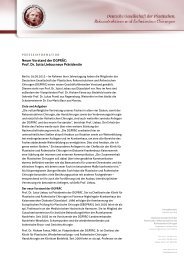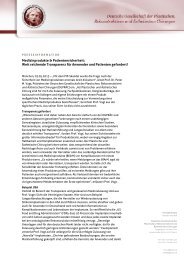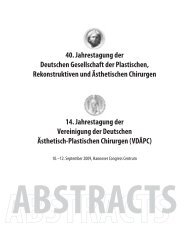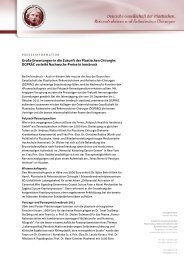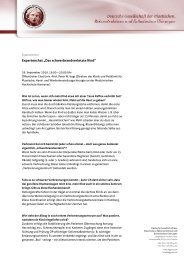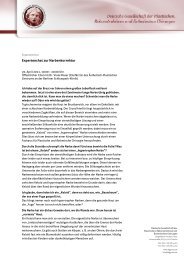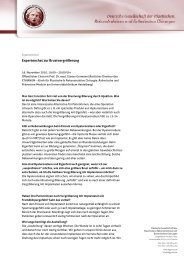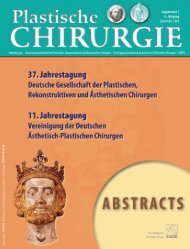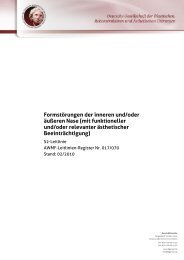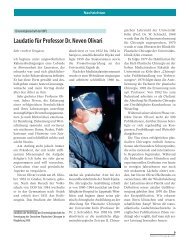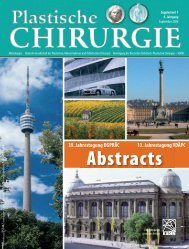ABSTRACTS
ABSTRACTS
ABSTRACTS
Erfolgreiche ePaper selbst erstellen
Machen Sie aus Ihren PDF Publikationen ein blätterbares Flipbook mit unserer einzigartigen Google optimierten e-Paper Software.
34. Jahrestagung der Deutschen Plastischen Chirurgen<br />
8. Jahrestagung der Deutschen Ästhetisch-Plastischen Chirurgen<br />
Cell densitiy in group I: 0,08 x 106/cm2. Transplanted area: 3 x 3 cm.<br />
Wounds observed until day 21 postoperatively. Histological observation<br />
with H&E.<br />
Results: In-vitro: In addition to human and porcine keratinocytes the spinning-culture-system<br />
on fibrin-microcarriers is also appliable for microvascular<br />
endothelial cells and human preadipocytes. Optimal proliferative<br />
and migratory potential of cells in spinning-culture verified. Fibrinmicro-carriers<br />
could be used as a one-step culture-, transplantation- and<br />
carrier-system for the recombinant growth factor rhEGF.<br />
In-vivo: One could demonstrate the capability of this system to reconstitute<br />
a multilayered, stable and regenerative epithelium in the athymic<br />
nude-mouse-model as well as with autologous cells in the immuncompetent<br />
porcine model. Until day 14 wounds were completely closed. Histological<br />
examinations:day 21: complete degradation of fibrin-carriers. No<br />
cellular inflammatory reaction. Epithelial thickness comparable to results<br />
of standard KFGS-group.<br />
Pure epithelial graft with fibrin-microcarriers, without any dermal components<br />
in matrix material, and only one sixth of the cell amount of the<br />
mouse model was capable to reconstitute multilayerd, stratified and stable<br />
epithelium with rete digits in immuncompetent porcine animal model.<br />
Discussion: Spinning culture provides a great amount of cells in a short period<br />
of time, easy to handle, cost-effective and avoids negative enzymatic<br />
effects directly.before transplantation. Multiple cell types can be cultured<br />
on fibrin-microcarriers. Therefore it is an interesting alternative for coculture<br />
and co-transplantation in the field of tissue-engineering. Additional<br />
in-vitro experiments were focused on loading the fibrin-carriers<br />
with the recombinant growth factor (rhEGF).Levels of secreted rhEGF<br />
by fibrin-carriers ranged constantly in the therapeutic level between 1500<br />
and 200 pg/ml after day 4 (transplantation). These in-vitro results<br />
demonstrate an interesting prospective for the in-vivo-stimulation of the<br />
wound-healing process during the first days after transplantation with<br />
fibrin-microcarrier.<br />
P180 Natrium Chlorosum (DAC N-055) on the Brink of<br />
Becoming a New Orphan Drug to Treat Leishmaniasis Cutanea in<br />
Kabul?<br />
K.W. Stahl 1 , F.M. Amin2 , S. Stecher1 , Br. Reto2 1 2 Waisenmedizin e.V. Freiburg, c/o Allgemeinpraxis S. Stecher, Freiburg, Dermatological Day Clinic „Dawarzee e<br />
Lahory in Kabul“ of the German Medical Service, Christusträger Brüder Kloster Triefenstein<br />
One of us reported the healing of an ulcerous lesion of a 77 year old Fontaine<br />
IIIb patient with a 9.5 mM chlorite solution. This was suggested in<br />
1984 [1] to act as a mineral oxygen carrier forming so called tetrachlorodeca-oxygen.<br />
The clinical efficiency was true [2], the chemical hypothesis<br />
and the explanations of the molecular pharmacology were not.<br />
In 1992, commercially available sodium chlorite with its well known toxicity<br />
[3] received a monograph in the Deutscher Arzneimittel Codex (DAC<br />
N-055). As the German pharmacists believed TCDO to be a hoax, they<br />
were convinced that commercial NaClO 2 would do the moist wound care<br />
job of „TCDO“, as had been published in more detail in1986 [3], in a more<br />
economic way.<br />
The crucial need for an efficient low cost treatment of heavily infected<br />
wounds in orthopaedic surgery in those 49 least developed countries<br />
(LDC) which are in a post-war situation such as Afghanistan, prompted<br />
us to look into the question again: Under which circumstances does the<br />
chemical chlorite become a pharmaceutical? If chlorite (ClIII) is synthesized<br />
from pure ClO 2 the formation of chlorate is prevented, this<br />
NATRIUM CHLOROSUM (Na-Chl) acts as an anti-infective promoter<br />
of tissue regeneration, apparently containing ClV as peroxychlorate<br />
(NaOOClO 2) [4].<br />
Plastische Chirurgie 3 (Suppl. 1): 107 (2003)<br />
Leishmaniasis is endemic in Kabul and surroundings and the GMS has<br />
photo documented and filed every case they treated on their PC during<br />
recent years. In 2002, we found by accident that 0,1 % Na-Chl promotes<br />
the healing process of Leishmaniasis ulcers. Meanwhile 5 cases initially<br />
showing parasites in the non-necrotic wall of the ulcers have been followed<br />
up by microscopic examination. To our great surprise the parasite<br />
disappeared completely in all 5 cases in the course of wound healing.<br />
One of us, who will present our findings, now also uses moist wound<br />
treat-ment with a magistral preparation of 0.1 % Na-Cl for infected chronic<br />
wounds of immune-depressed and diabetic patients in his general<br />
practice in Freiburg. On demand he will demonstrate the case of a rheumatic<br />
patient for whom wound healing could be achieved after a therapeutic<br />
odyssey of 2.5 years.<br />
[1] Hinz J, Kuhne FW, Stahl KW (1984) Local tetrachlorodecaoxide to improve oxygen<br />
supply to non-healing wounds. Lancet I: 630. [2] Sodium chlorite CAS 7758-19-2, in Tome<br />
6 „Kurzfassung Toxikologische Bewertungen der BG Chemie“ (2001) p 84 (18 volumes<br />
of toxicological evaluations of NaClO2 to be obtained from Berufsgenossenschaft der Chemischen<br />
Industrie, Heidelberg). [3] Hinz J, Hautzinger H, Stahl KW (1986) Rationale for<br />
and results from a randomised, double-blind trial of tetrachlorodecaoxygen anion complex<br />
in wound healing. Lancet 1: 825-828. [4] Svenson T, Nelander B, Bernhardsson, A. Karlström<br />
G (1999) Infrared spectroscopic and ab initio study of HOOClO2. J Phys Chem A<br />
103: 4432-4437<br />
P181 Tissue Engineering von autologem Gelenksknorpel unter<br />
Verwendung von PEGT/PBT-Copolymer-Trägern<br />
und deren Transplantation zur Rekonstruktion von kleinen<br />
Gelenken im Tiermodell<br />
V. Wedler<br />
Klinik für Wiederherstellungschirurgie, Universitätsspital Zürich<br />
Abstracts<br />
107





